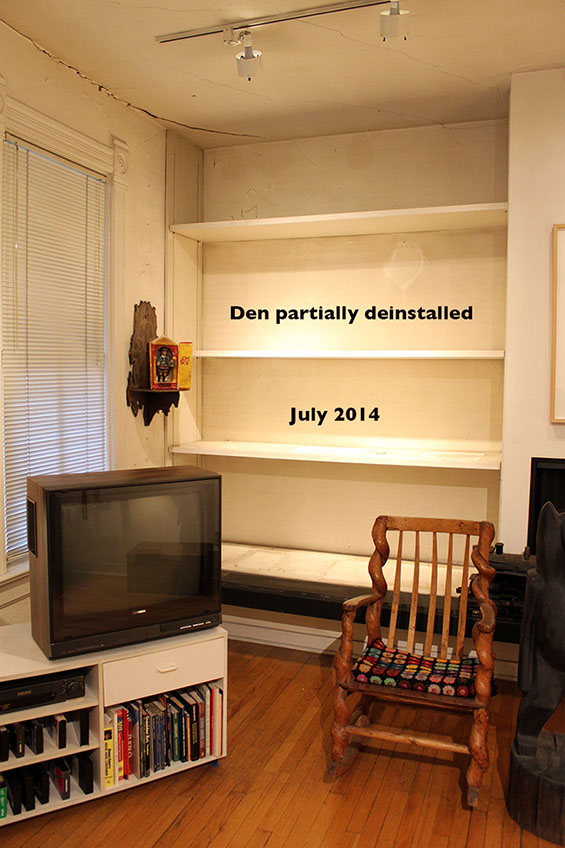Posted in ALL THE NEWS on Wednesday, August 26th, 2015
Greetings from the RBSC at the tail end of summer. Spring semester went by in a combined blur of class and staff projects. A few highlights include Nick Lowe’s Sophomore Seminar students who morphed ideas about Roger Brown works of art with areas of interest in the Roger Brown Study Collection, and installation strategies, into the exhibition Sophomore Sensations, installed briefly on the Yoshida shelves.
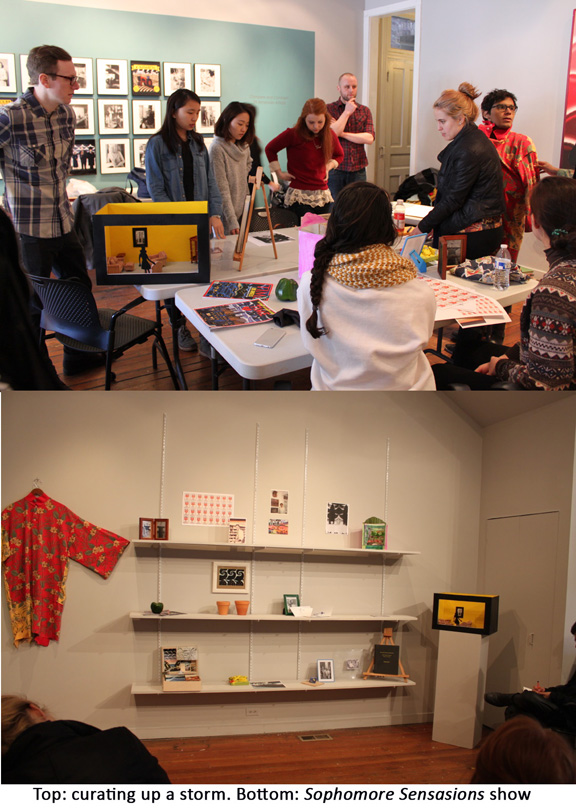
Frédéric Moffet’s Intimacies class (Film Video New Media Animation) held An Intimate Affair at 1926 on a balmy Sunday afternoon in May. Students screened outstanding films and performed intriguingly to an audience of significant sweethearts. A charged time was had by all, and Frédéric managed to arrange a surprise downburst, a refreshing end to the midspring afternoon.
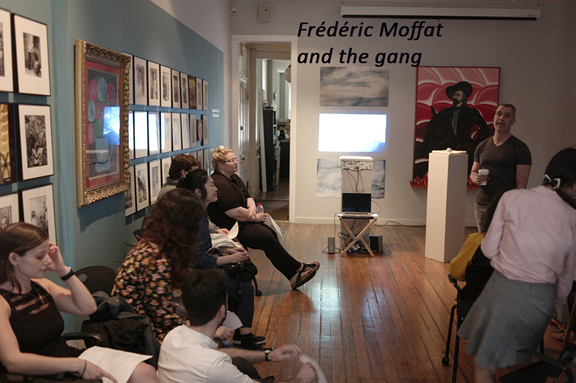
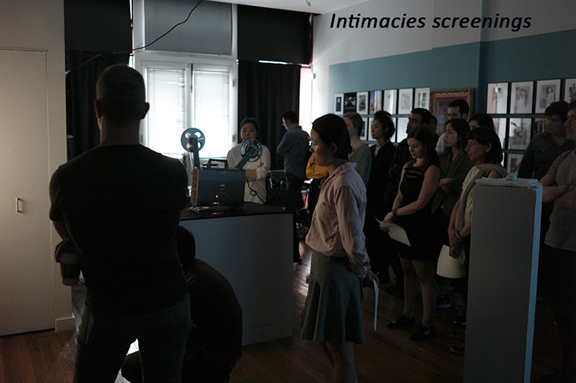
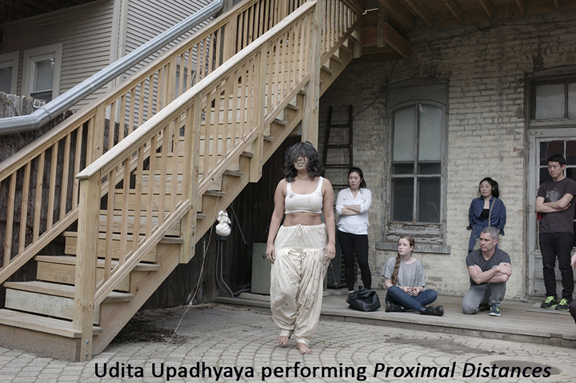
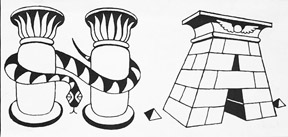
On June 11 a solemn ceremony was held for the inurnment of a portion of Harold Allen’s ashes at Graceland Cemetery. Renowned and revered as artist, scholar, teacher, friend, and avowed Egyptomaniac, as his signature initials above convey (!), Allen joins a pantheon of extraordinary people who impacted Chicago forever. We are eternally grateful to Scott Dietrich for shepherding the Harold Allen Study Collection (HASC) into SAIC’s collection of Special Collections. The inurnment marks renewed efforts to organize the extraordinary materials in the HASC for access.
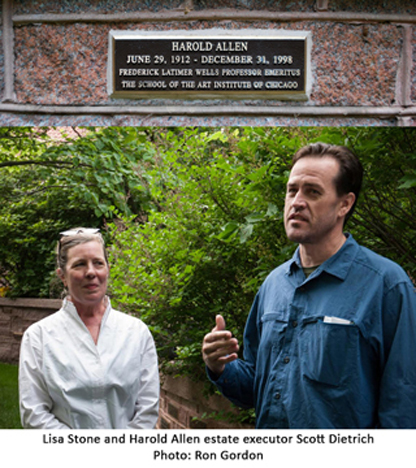
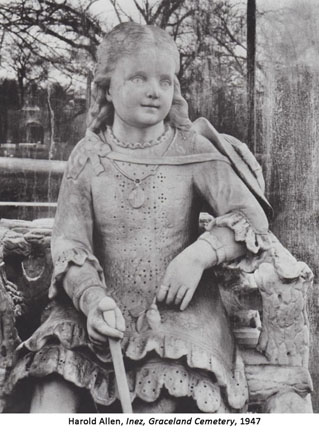
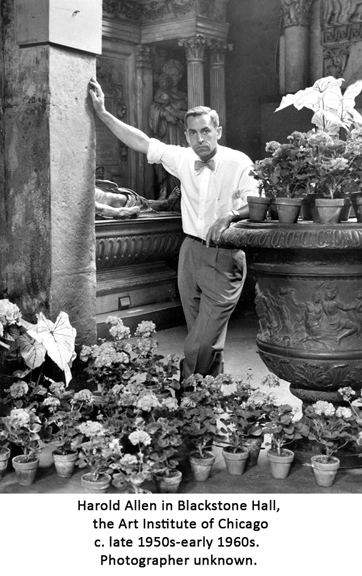
AT LONG LAST, The project to digitize all (21) of Roger Brown’s sketchbooks was completed in June. The sketchbooks reveal the origin and development of Brown’s creative process, providing insight into his ideas from early years to his final works. They are original, irreplaceable drawings invaluable in the interpretation of the resulting artworks, while revealing ideas that never went further than a sketch.
The sketchbooks are now safely stored in the Prints and Drawings Department at the Art Institute of Chicago, where they are on long-term loan and accessible to scholars, the curious, and sketchbook-obsessed. Now begins the project to write metadata for each page, then Chris Day, Digital Services Librarian at Flaxman Library, will organize the images into an online collection. Our thanks to Leigh Armstrong and Armstrong-Johnston staff for their special care and expert digitization, and to Mark Pascale, the Janet and Craig Duchossois Curator of Prints and Drawings at the Art Institute of Chicago.
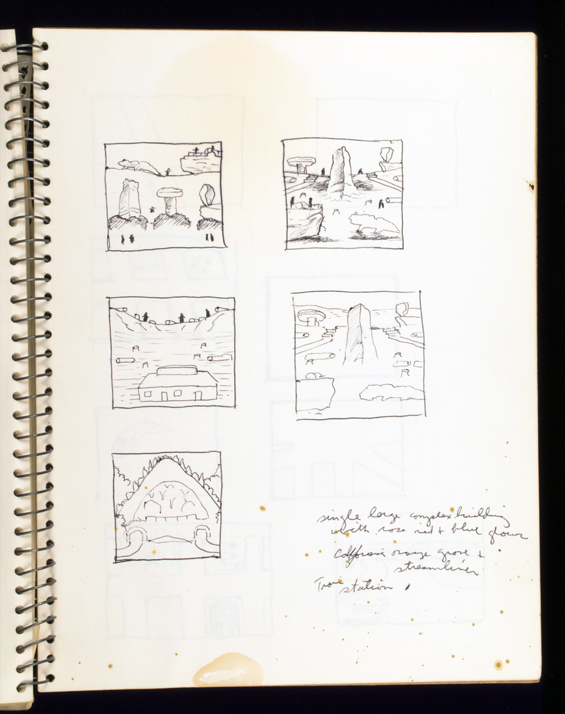
Page in Brown’s 1972 sketchbook.
East Coast
Works from the Roger Brown estate were on view in two outstanding New York exhibitions, Roger Brown: Political Paintings at DC Moore Gallery (June 18 – August 7, with catalog) and Roger Brown: Virtual Still Life at Maccarone (June 25 – August 14). Both shows received excellent press––see links to reviews below. Huge thanks to Russell Bowman Art Advisory, Jay Gorney, and all staff at DC Moore and Maccarone, for showcasing two diverse and critical dimensions of Brown’s remarkable oeuvre.
Roberta Smith’s New York Times reivew, Maccarone; Ken Johnson’s New York Times review, DC Moore, ARTnews, New Yorker , Art in America.
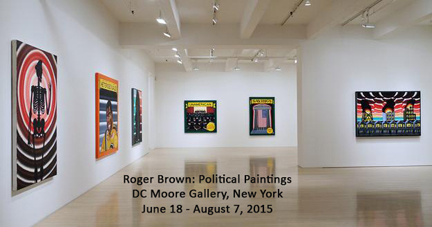
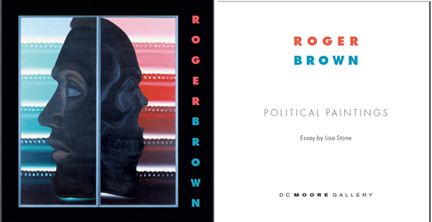
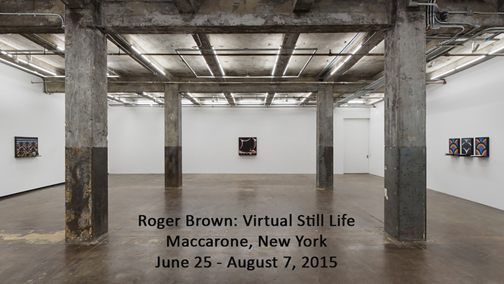
West Coast…
The last chapter of Roger Brown’s life––creating a home, studio, gardens, collections, and extraordinary body of work in Southern California––is explored in depth, in Jonathan Griffin’s insightful article in East of Borneo.
Meanwhile, back at 1926
Roger Brown’s devotion to conflating high style with vernacular is ingeniously distilled in his 1926 N. Halsted St. garden. Grand Greco-Roman statues of Persephone and Neptune gaze down upon four classically-styled jardinière and a table, all of cast concrete, of the sort that many would consider “ersatz.” Teak English garden seating lends a warm––and maybe for some, sophisticated––note to the setting. The objects rest on a radiating pattern of pavers, redolent of flooring of the Florentine Renaissance. They radiate around the catch basin manhole cover. IN this garden notions of high and low blur. All are subject to the Midwest weather and well past due for a cleanup. Don Howlett / Preservation Services, Inc., cleaned all the objects of atmospheric staining and buildup of biological growth. Hairline cracks and broken areas were repaired, and all received a surface treatment to deter moisture penetration and protect interior metal.
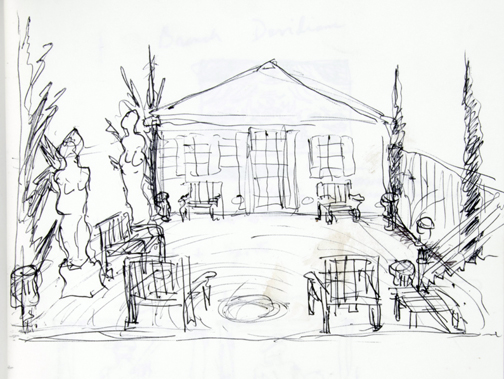
Brown’s sketch for the garden at 1926 N. Halsted St. From his 1993-1997 sketchbook.
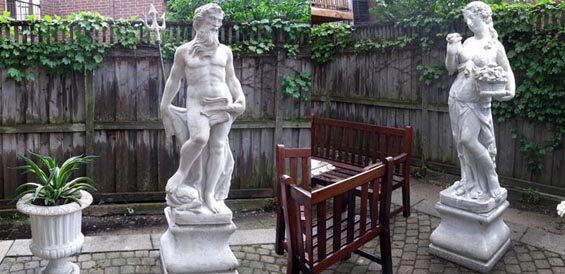
Preserving 1926 Preservation contractor and SAIC faculty member Neal Vogel and his Restoric crew are hard at work on the project to restore all the doors, windows, and transoms, and create new, wood framed, UV filtering storm windows for the second floor. This project is generously funded by the Walter and Karl Goldschmidt Foundation, to whom we are most grateful! Stay tuned for a full report in our fall semester update.
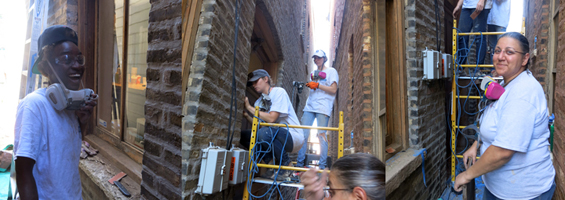
Restoric crewmembers left to right Adjua Pryor, Elizabeth Fisher, Erin Gibbs, and Roseanne Ghazarian.
BLANKETY BLANK BLANK!
Roger Brown acquired 36 drawings by venerable master artist Joseph Yoakum. As fragile works of art on paper the trove is subject to deterioration from exposure to light. Thus, we regretfully remove them for a rest rotation for half of each year––March through August––transforming the Yoakum Room from a warm and rich place to a barren one. After some years of fumbling, we realized we could restore a measure of the room’s soul by installing 36 blanks. Guests enter the room and gasp in awe, imagining the works they can’t actually see. The drawings will be reinstalled by the end of August so you’ll have to come back next March to catch the curiously empty display.
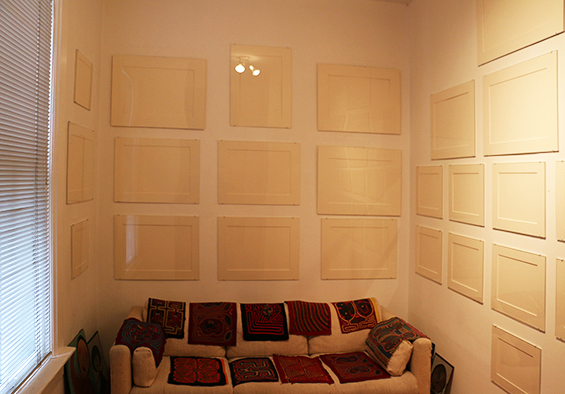
Yoakum Room with blank mats
Lisa Stone, August 2015
The Roger Brown Study Collection is pleased to present the exhibition Compare and Contrast: 39 American Artists, an expanded version of a traveling show from the Historic Artists’ Homes & Studios, a program of the National Trust for Historic Preservation, showcasing the artists in the consortium.
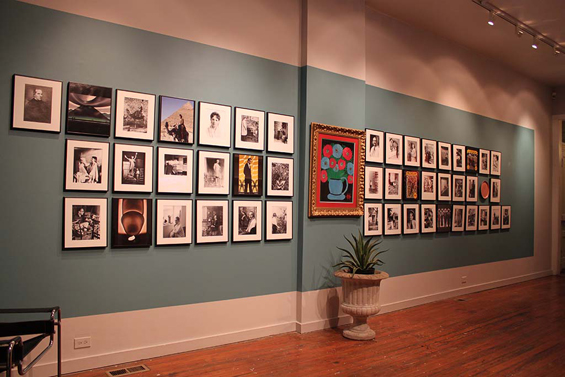
In 2000 the Roger Brown Study Collection (RBSC) joined the Historic Artists’ Homes and Studios (HAHS), a consortium of 39 member sites from across the United States committed to the preservation, interpretation, and accessibility of spaces where American artists lived and worked. You can explore the individual sites on the HAHS website.
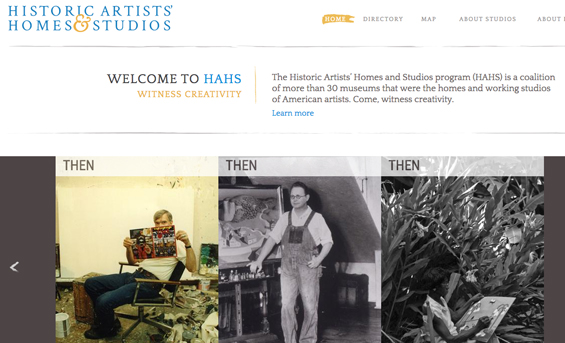
HAHS member sites include iconic artists such as Winslow Homer’s rustic cottage perched on the Maine coast (below, left), the paint-splattered barn used by Jackson Pollock and Lee Krasner in East Hampton, Long Island (below, right), and 101 Spring Street, New York City, the home, studio, and collection environment of Donald Judd (below, center), to name just a few.

HAHS organized a traveling exhibition of 39 black and white photographs of artists, which has traveled to six sites since 2012. The timeframe the HAHS artists span begins with Thomas Cole, born in 1801, and ends with Roger Brown, born 140 years later. Representing a diverse range of painters, sculptors, photographers, furniture makers, and other artists, the HAHS artists are associated by the circumstance that their sites are preserved and open to the public, providing visitors with the opportunity to experience the intimate spaces where artists lived and worked.
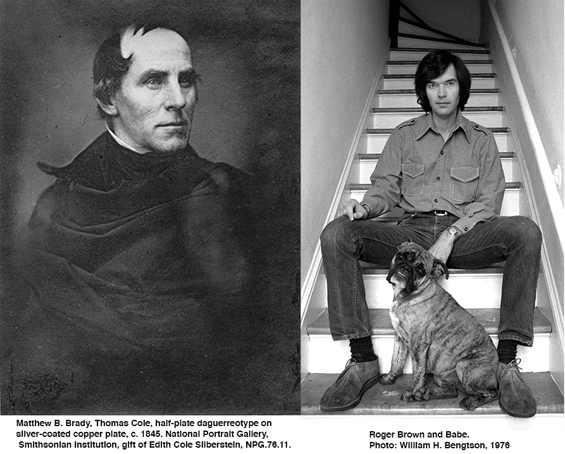
RBSC staff revamped the exhibition to explore this somewhat random cross-section of American art history through the lens of Roger Brown’s ideas, critiques, and related works, in hopes of inspiring ideas and rigorous comparing and contrasting of/by SAIC’s faculty, students, and staff, and our guests.
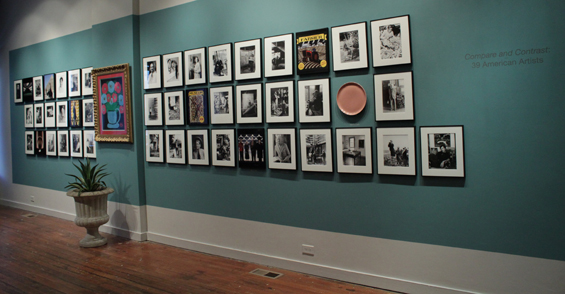
Compare and Contrast is anchored by a robust painting of Zinnias by Clementine Hunter (Melrose Plantation, Melrose, Louisiana, from the collection of Jim Zanzi), to represent Roger Brown’s fervent commitment to the work of artists who worked outside of the academic mainstream.
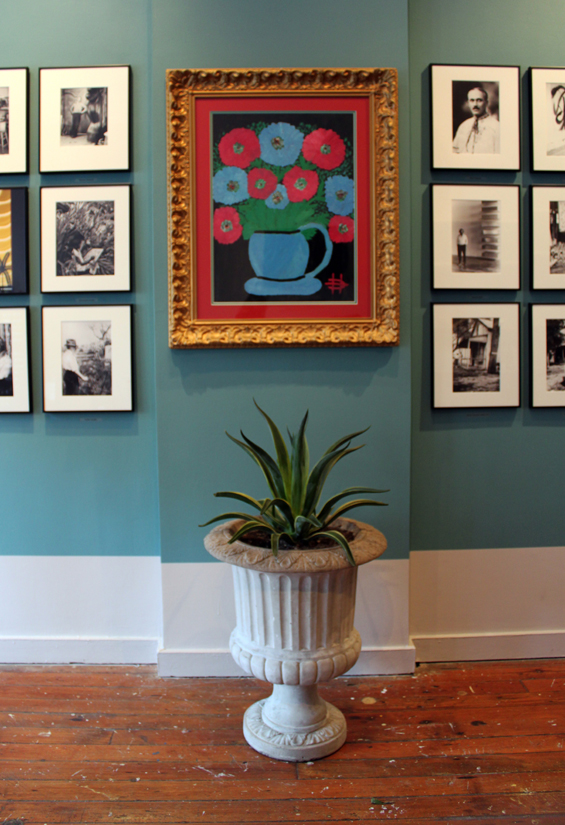 Clementine Hunter (1887-1988), untitled painting (zinnias in blue pitcher),
Clementine Hunter (1887-1988), untitled painting (zinnias in blue pitcher),
c: 1970s-80s, oil on canvas, 23 x 18 ½ inches, collection of Jim Zanzi
Also on view, Brown’s Ring of Fire (Buffalo Bill in Hell, 1988) invites reflection on representations of America’s landscapes, history, and historical figures, in artworks, and directs attention to representations of the American West and historical attitudes toward Native Americans that are critiqued and debated today.
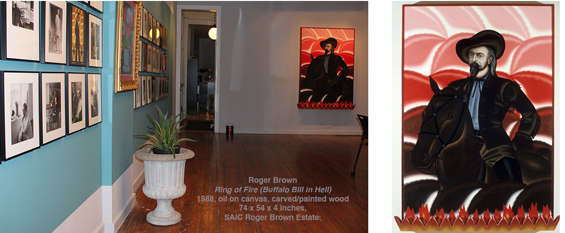
Ever the observer and critic of the art world and its history, Brown made paintings referencing artists or histories in the HAHS consortium. We found connections to works by Augustus Saint-Gaudens, Georgia O’Keeffe, Grant Wood, Thomas Hart Benton, Jackson Pollock, and painters of the American landscape, among Brown’s oeuvre. Color reproductions of six paintings are mixed in with the black and white portraits. Brown dined on Russel Wright American Modern dinnerware (in his modernist home in Michigan) and a coral dinner plate punctuates the installation. We included a photo of Brown astride a camel next to the photo of Frederic Church astride a camel, to highlight the importance of travel to distant lands, for historical and contemporary artists.
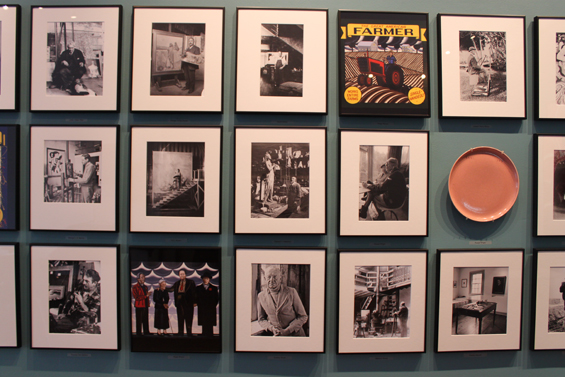
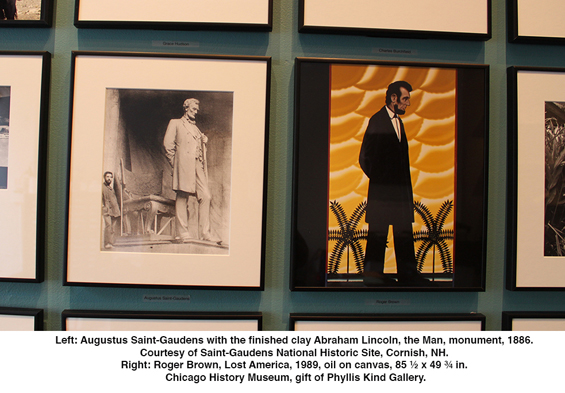
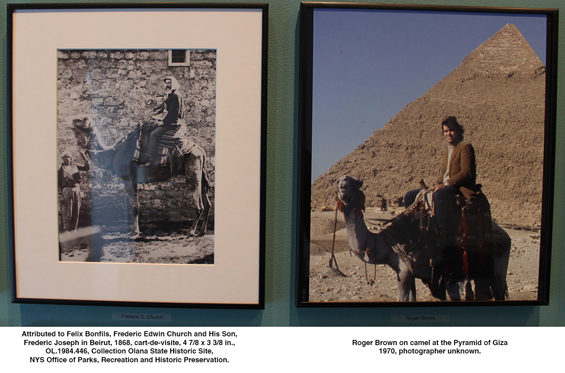
We assembled a mini-library of books on the HAHS artists (borrowed from SAIC’s Flaxman Library), so information and images on the artists are on hand.
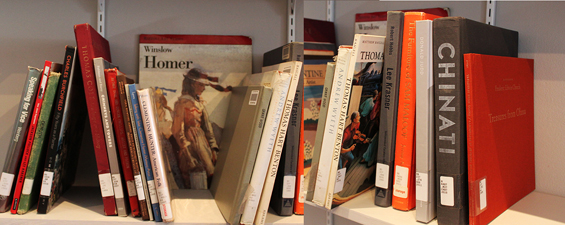
Compare and Contrast includes a slideshow with an introduction to each artist and their home & studio, showing works by HAHS represented in the Art Institute of Chicago. A guide with Art Institute floor plans identifies 62 artworks by HAHS artists that are currently on view, offering a kind of scavenger hunt through the museum, to works as diverse as Thomas Cole’s Distant View of Niagara Falls (1830), to an untitled work by Donald Judd (1968), to Jackson Pollock’s The Key (1946), and many more.
Images:
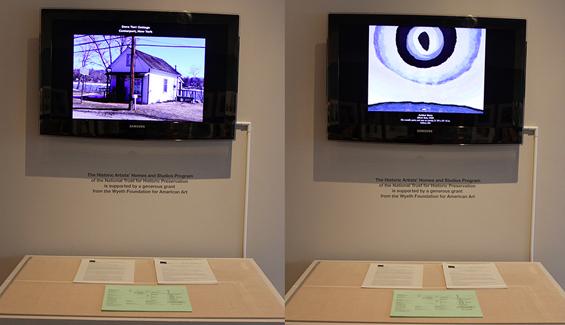
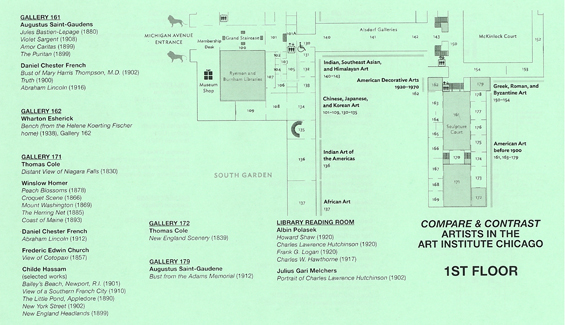

Co-curator Olivia Junell (Art History/Arts Administration dual degree grad student) created and designed an accompanying booklet, with information and quotations about and by each artist.
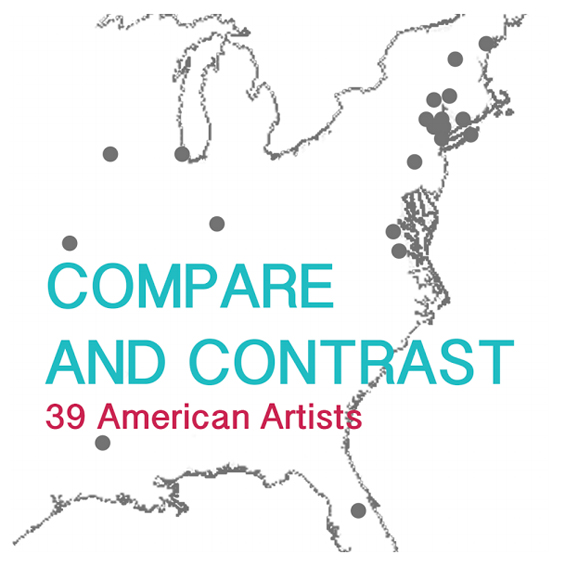
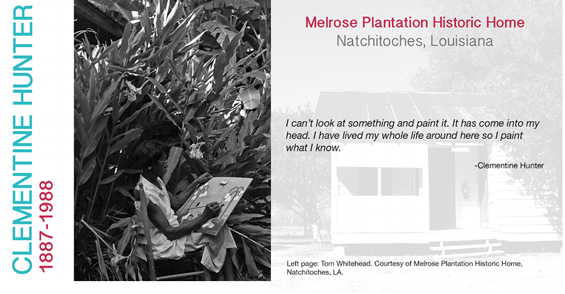 Compare and Contrast booklet cover and sample pages
Compare and Contrast booklet cover and sample pages
On February 11, Art Historian Jason LaFountain gave the lecture Both/And American Art here at the RBSC.LaFountain, who teaches in SAIC’s Art History, Theory, and Criticism department, explored Brown’s work in relation to many of the HAHS artists and sites (including other sites he thinks should be in the HAHS consortium), and teased out insightful connecting threads between and among the artists. Using Robert Venturi’s Complexity and Contradiction in Architecture––a text dear to Roger Brown––as a conceptual framework, the lecture positioned Brown’s artistic production in relation to Venturi’s theorizations of the “both-and” in architecture” and “the difficult whole.”
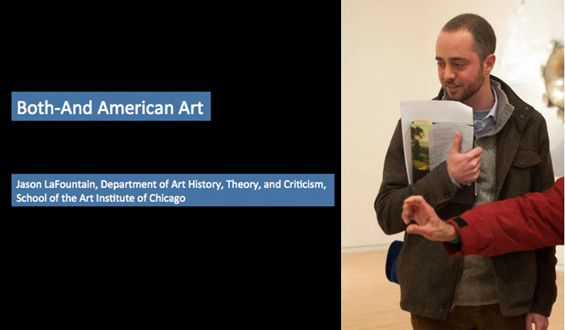
The Historic Artists’ Homes and Studios Program of the National Trust for Historic Preservation is supported by a generous grant from the Wyeth Foundation for American Art. We hope Compare and Contrast will inspire our guests to experience these sites in person, and to support HAHS’s mission of preserving these special places that are vital to the nation’s cultural heritage. Many thanks to Donna Hassler (Director of Chesterwood and Administrator of the Historic Artists’ Homes and Studios program), and Chesterwood staff.
Note: the subtitle “39 American Artists” was publicized before we realized that in the exhibition of 39 photos, there are actually 40 artists in the exhibition. Helen Torr and Arthur Dove are in the same photo, taken at the Dove/Torr Cottage, Centerport, New York.
Compare and Contrast: 39 American Artists
January 22 – May 8, 2015
Roger Brown Study Collection, the School of the Art Institute of Chicago
1926 N. Halsted St., Chicago * by appointment, 773. 929-2452, rbsc@saic.edu
Posted in Uncategorized on Saturday, November 22nd, 2014
Greetings, from our garden to yours. Roger Brown left this world 17 years ago today, November 22, 1997. We remember him for many things, especially for his exceptional generosity to the School of the Art Institute of Chicago. We always say that he didn’t have to teach in his lifetime, but he’s been teaching 24/7 ever since. We are eternally grateful.
Things have been hopping at the RBSC all summer and fall, and there’s much to report. Before diving in I’d like to express sincerest thanks to SAIC deans and administrators, Office of Institutional Advancement, and Instructional Resources and Facilities Management staff, for many exciting improvements to the building, grounds, and collection. As always, thanks to RBSC staff and volunteers for stellar work.
 Garden, 1926 N. Halsted Street
Garden, 1926 N. Halsted Street
Good news first: preservation of the building and garden
We received a very generous grant for $49,000 from the Walter and Karla Goldschmidt Foundation for the project to restore the doors, windows, and transoms and create all new storm windows! Treatments are outlined to preserve elements present from 1974 to 1995, the years Brown lived at 1926 N. Halsted St. New storm windows will be fitted with UV filtering glass, introducing a large measure of protection for the collection while increasing energy efficiency. This milestone project will greatly improve the building’s appearance and extend the life of its historic 1888 features well into the 21st century. We are especially grateful to the Walter and Karla Goldschmidt Foundation for their continued support of the RBSC. A previous grant from the Foundation funded the major restoration of the historic storefront and apartment doors, completed in 2012. We’ll spend the winter planning for the project, to begin in spring 2015.
 Existing conditions of a few doors and windows.
Existing conditions of a few doors and windows.
In October Neal Vogel / Restoric removed the apartment door for maintenance and touch up; the wood and cast iron elements of the storefront received maintenance and touch ups as well.
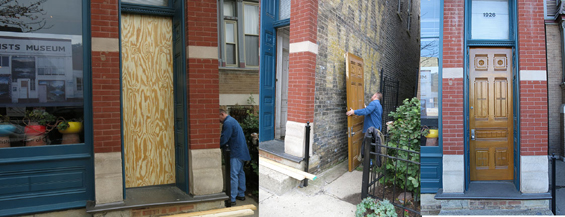 Left: Apartment door boarded up. Center: Neal Vogel/Restoric removing door. Right: Restored door, lookin’ good!
Left: Apartment door boarded up. Center: Neal Vogel/Restoric removing door. Right: Restored door, lookin’ good!
Back to the garden…
The project to remove the existing porch and stairs––which we’ve barely been able to use since 1997––and replace them with a code compliant structure was a great success. SAIC’s IRFM team and Structures Construction first created a design that would accommodate the two conifer trees planted by Brown in 1994, but after much consideration we realized that the design would be incoherent if the trees died and were removed, and we settled on a straight-run stair design, similar to the original.
The new stairway and porch, completed in late August, have transformed the garden into an enchanting and much more usable space, with fluid circulation between the floors. Many thanks to Structures Construction and IRFM staff, especially project manager Vince Bertucci.
 Left: view of the garden before construction, with fallen juniper. Right: new porch and stairway.
Left: view of the garden before construction, with fallen juniper. Right: new porch and stairway.
Tours and guests
By the numbers: 2014 has brought nearly 100 SAIC classes and ~ 2150 guests.
Fall semester began with Historic Preservation and AIADO departmental receptions and we hosted the Chicago Area Archivists, among other groups.
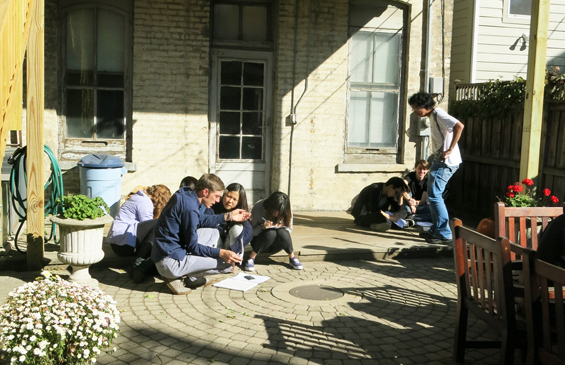 Tim Nicodemus with Research Studio students working in the garden.
Tim Nicodemus with Research Studio students working in the garden.
Students in Patricia Rieger’s Curious, Intimate Object ceramic class explored the collection, made works in response; a month later they installed their works throughout the collection for a class critique. This pushes us into transgressive zones of house museum management (!), but is well worth the effort. The temporary introduction of new works into Brown’s home/collection continues the creative record of the building and collections, enhancing the lab aspect of our interpretation of the curious and intimate oxymoron we know as house / museum.
 Curious, intimate ceramic objects by Alejandra Isabel Moreno (left), Erica Gero (center) and Katie Doyle (right).
Curious, intimate ceramic objects by Alejandra Isabel Moreno (left), Erica Gero (center) and Katie Doyle (right).
Nicholas Lowe’s Research Studio freshmen spent a morning exploring Roger Brown paintings, selected by Nick, to align with each students’ interests. After learning about Brown’s Virtual Still Life works, they went on a hunting expedition through the RBSC, to discover objects of interest. They were assigned the task to create their own, virtual Virtual Still Life, combining images from the home collection with Roger Brown paintings. The students rose to the occasion with verve and originality, enriching the ongoing project of what could be…..
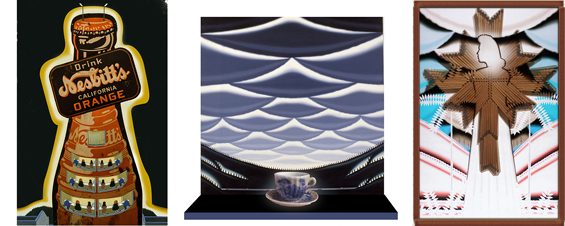
Research Studio untitled projects by artists Koy Suntichotinun (left), Yuexin Zhou (center), Li Yue (right).
Compatriots
We were delighted to host Lauren Bon and the Optical Division of Metabolic Studio team of remarkable artist/explorers––all in town for Chicago Humanities Festival events––with friends from the DePaul Museum of Art. The Metabolic Studio team gave an outstanding presentation about their work with the Liminal Camera in Chicago. Lauren and Optical Division artists plan to deploy the Liminal Camera elsewhere in the region this spring, exploring the complex relationships between people, waterways, and social and environmental ecologies, recording their findings through ingenious processes.
 Left: Tristan Duke and Lauren Bon show an astonishing photo at 1926.
Left: Tristan Duke and Lauren Bon show an astonishing photo at 1926.
Right: Freshly processed print of the Chicago Stockyard entrance taken with the Liminal Camera.
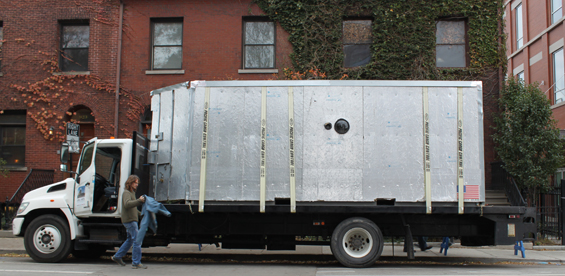 The Liminal camera near the DePaul Museum of Art
The Liminal camera near the DePaul Museum of Art
Collections
Conservation: The trusty and ever-careful Tim Fox installed backings on all the paintings (30) that are on stretchers or strainers, allowing us to breathe sighs of relief about the care and life of many extraordinary paintings on canvas in the RBSC. Interesting details were found when examining the painting’s versos. We removed five Kilims and one Afghan rug in the La Conchita collection from offsite storage and had them cleaned and professionally wrapped. More sighs of relief…
 Details, Painting before backing was applied (left); Kilim before cleaning (right).
Details, Painting before backing was applied (left); Kilim before cleaning (right).
TOP THIS! Treasure trove of Roger Brown’s slides, now online
Last summer staff scan-a-holic Molly Hewitt digitized over 2000 slides taken by Brown over the years, and uploaded them to a flickr website: https://www.flickr.com/photos/rbsc/ , aka “the motherlode!”
The slides document Brown’s travels around the country and overseas, and his discoveries of roadside signage, yard shows, art environments, arrangements of objects, streetscapes, vernacular architecture, and other wonders both ordinary and extraordinary. We’re thrilled to have these images online and accessible. Treat yourself to a gambol through the visual landscape that caught Brown’s eyes and camera.
 3 random images from the Objects, Signs, and Window Displays album (441 images)
3 random images from the Objects, Signs, and Window Displays album (441 images)
And speaking of “the cloud…”
We’re well into the project of making high resolution, corrected digital files of all of Brown’s artworks, and working with Flaxman Library staff to make all the images available on the ArtStor and Shared Shelf websites. We hope to have the project completed in 2015.
new staff
We welcome Kaveri Raina (left, painting/Drawing grad), Henry Graser (center, freshman), and Katie Doyle (right, ceramics grad).
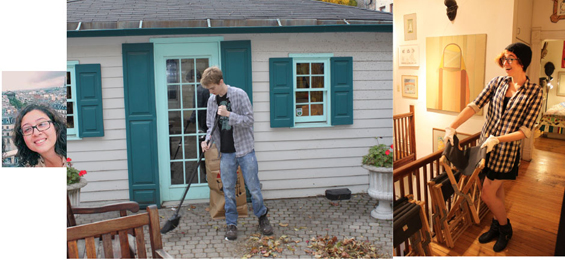
Russell Bowman Art Advisory
We commend Russell Bowman and his staff for the elegant Roger Brown: Virtual Still Life exhibition, on view at Russell Bowman Art Advisory from September 5 – November 1, 2014. The exhibition featured eleven Virtual Still Life object paintings (from the series of 27 works made in 1995 and 1996), from SAIC’s Roger Brown Estate Collection. Nicholas Lowe gave two outstanding lectures at the gallery, widening and deepening our understanding of this series, in which Brown leveled the playing field between “high” and “low,” and distilled the essences of much that mattered to him into sublime conversations between object and painting.

Loans
Two works in the RBSC from 1968 rocked (or are still rocking) exhibitions in England and Rhode Island. Christina Ramberg’s Bagged was on view in the Liverpool Biennial Exhibition, A Needle Walks into a Haystack, curated by Mai Abu ElDahab and Anthony Huberman, from July 3 to October 26.
Jim Nutt’s Officer E. Doodit is on loan to the exhibition What Nerve! Alternative Figures in American Art from 1960 to the present at the Museum of Art, Rhode Island School of Design, September 19, 2014 to January 4, 2015, organized by Dan Nadel and Judith Tannenbaum. The catalog includes Roger Brown’s interviews with Hairy Who artists, published in the October 1985 issue of Chicago magazine.
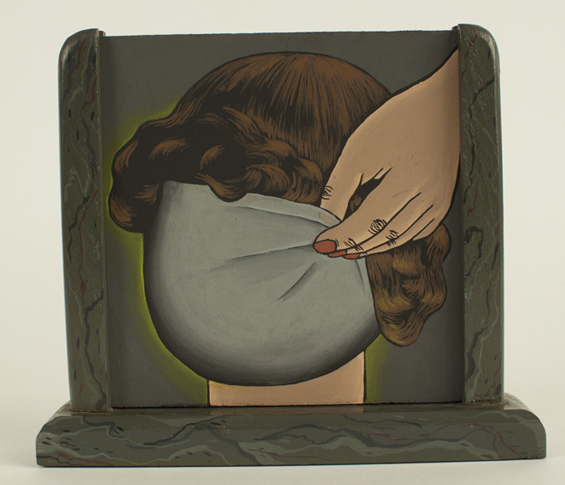 Christina Ramberg, Bagged, 1968, acrylic on Masonite, 7 x 8 x 1 ¾ in.
Christina Ramberg, Bagged, 1968, acrylic on Masonite, 7 x 8 x 1 ¾ in.
 Left: Jim Nutt, Officer E. Doodit, 1968, acrylic on Plexiglas, enamel on wood frame, brass hardware 24 5/8 x 21 x 1 ¼ in.
Left: Jim Nutt, Officer E. Doodit, 1968, acrylic on Plexiglas, enamel on wood frame, brass hardware 24 5/8 x 21 x 1 ¼ in.
Right: What Nerve…! Catalog.
 Installation view, What Nerve! Alternative Figures in American Art, 1960 to the Present, Museum of ARt, Rhode Island School of Design. Photography by Erik Gould. Courtesy of the RISD Museum.
Installation view, What Nerve! Alternative Figures in American Art, 1960 to the Present, Museum of ARt, Rhode Island School of Design. Photography by Erik Gould. Courtesy of the RISD Museum.
New Buffalo, Michigan landscape preservation
Kirk Wagner and the Upstream Waters crew planted several hundred native plants and grasses in between and around the River Pavilion and the Studio and Guest House, to re-establish the lush meadow planted by Brown and Veronda, and the critical relationship of the original landscape to the buildings. This is a major phase of the landscape Preservation Plan, created by Carol Yetken, CYLA Design Associates and students in the Historic Landscape Studio class in 2008. 2014 was the sixth year of implementing phases of the preservation plan. We owe many thanks to Carol and former students, to Kirk Wagner and his Upstream Waters crew for their careful, sensitive work on site, and to IRFM staff. We look forward to spring 2015, and many more seasons ahead, to watch the new meadow take hold and evolve.
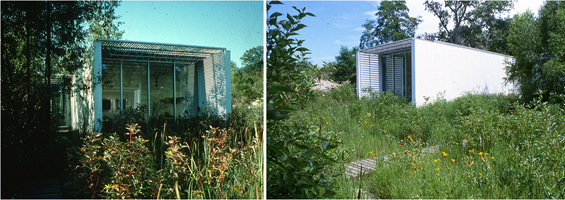 Vintage views, meadow between and around the Veronda buildings, Roger Brown property, New Buffalo, Michigan.
Vintage views, meadow between and around the Veronda buildings, Roger Brown property, New Buffalo, Michigan.
Photos: Bill Hedrich, Hedrich Blessing Studio. C. 1980.
 New Buffalo meadow planted summer 2014. Photos: Kirk Wagner
New Buffalo meadow planted summer 2014. Photos: Kirk Wagner
The overgrowth of wild, volunteer honeysuckle at the head of the driveway was removed, and replaced with a tidy screen of viburnum.

Greg Brown, new work!
Greg Brown has turned his mind and hands to marvelous, exotic portrait sculptures made of hypertufa, no doubt adorning the enchanted garden he and Benedicte continue to create. We miss Greg and Benedicte and hope 2015 sends RBSC staff to Alabama for a long-overdue visit.
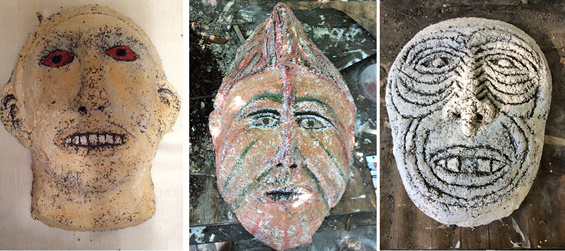 Greg Brown, untitled sculptures, hypertufa, 2014.
Greg Brown, untitled sculptures, hypertufa, 2014.
In closing, a letter from Aubrey Fisch
Aubrey Fisch, a senior studying Visual Communications, missed a trip to the RBSC with Nick Lowe’s What’s My Job class. Ms. Fisch wrote this reflection on her first visit to the collection as a freshman, four years ago.
I felt so bad this week, I don’t know how I completely forgot about meeting at the Roger Brown House, I guess I just got used to meeting in the classroom, or getting an email. But I remember now looking forward to it when Nick mentioned it in class, because I remember thinking that the last time I was there it was a fall day like this only it was my freshman year at SAIC in my research studio class, and it became this kind of really magical day amongst what was kind of a hard time for me. I remember I felt so lost in Chicago. Everything was so new and different, and I was really overwhelmed and confused and felt out of place in every way. I didn’t think I could make sense of things here, everything felt foreign and I didn’t think I could ever belong. I felt really homesick all the time, but it was accompanied with this feeling that I couldn’t go back, that I was in Chicago now and I had to make it work. But I remember on this day everything kind of fell in place. I remember it was the first time I rode an L train that was truly above ground so I could see Chicago, kind of slowly pass, I remember it felt like a floating feeling like a flying ship or something, and everything was really beautiful from this height. And when we got off I was really taken by this neighborhood, I remember it felt small and safe in a way I hadn’t felt for a long time.
Then when we got to the Roger Brown house, I was completely taken and inspired. It was everything I loved about art and everything that had made me want to follow it. Everything just felt so beautiful and I felt like a sponge absorbing it all. I remember I got really excited when I saw some Henry Darger works, because I recognized them from the Collection de l’Art Brut in Lausanne, which was a place I would go a lot back home. I didn’t even know he was from Chicago, or that these works even had significance outside of what I thought was this small peculiar museum back home.
Anyways, the thing is I feel like so much has changed since then. I finally feel like a bit more at place in Chicago, and that feeling has taken much longer than I ever imagined or hoped it would but I finally think I feel okay here. I was really looking forward to going back, because I love the collection, and also because I wanted to see if it felt different now, and to see if I could feel that change.
Lisa Stone, November 2014
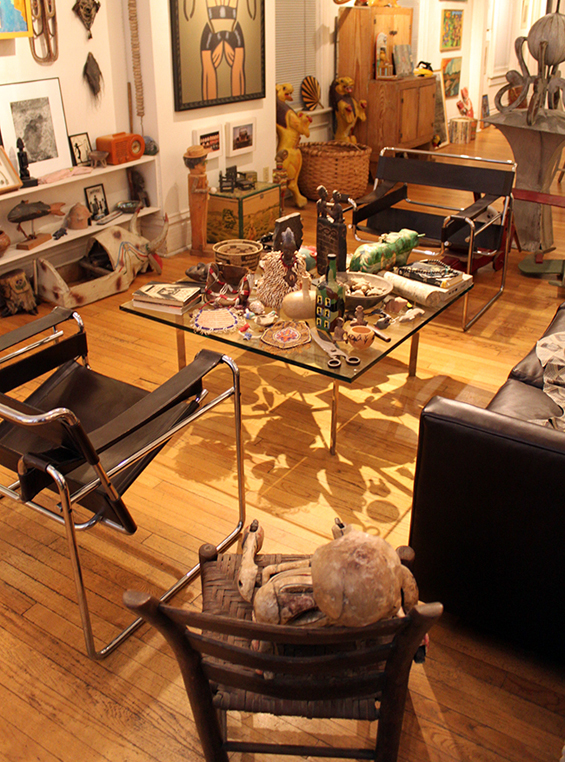 RBSC living room. Photo: Lisa Stone
RBSC living room. Photo: Lisa Stone
Posted in Uncategorized on Monday, September 15th, 2014
The project to replace the porch and stairway in the RBSC garden was completed just in time for fall semester receptions and waves of classes and other guests. We thank IRFM (SAIC’s Instructional Resource and Facilities Management ) staff and all contractors and workers for transforming the garden into a fully usable space.
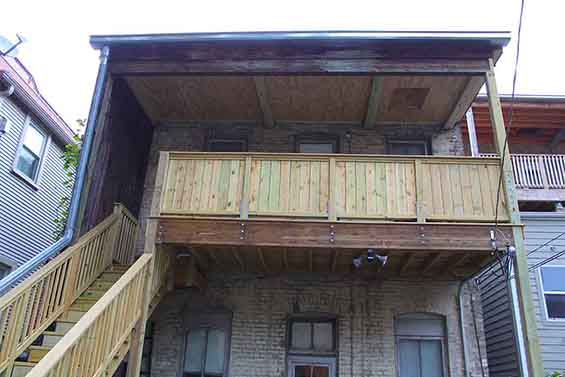

Posted in Uncategorized on Wednesday, July 9th, 2014
An exciting construction project in the 1926 N. Halsted Street garden has necessitated the deinstallation of a few rooms in the Roger Brown Study Collection. Many objects have been relocated temporarily throughout the collection so we are unfortunately not accessible for visits. We expect to be welcoming guests again in late August or early September. We apologize for the inconvenience. In the meantime, please peruse the links below to get a sneak peek at the collection, and view some collection videos. And of course, scroll through the blog to see what we’ve been up to.
Posted in Uncategorized on Wednesday, July 9th, 2014
The Roger Brown Study Collection is proud to be featured on the new website for the Historic Artists’ Homes and Studios program, a coalition of more than 30 museums that were the homes and working studios of American artists. Check it out at www.artistshomes.org.
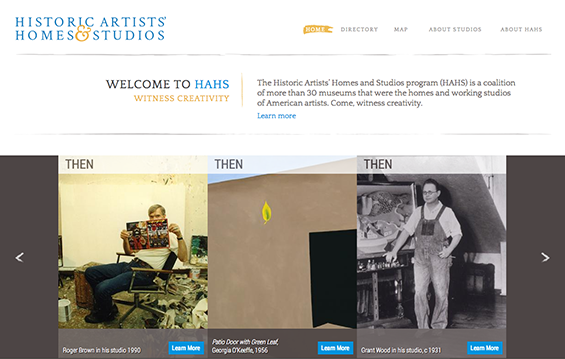
2014 has been mostly winter so far, with hints of spring finally on the horizon. Here’s what’s been happening at the RBSC, while we watch the buds blossom and the flowers bloom.
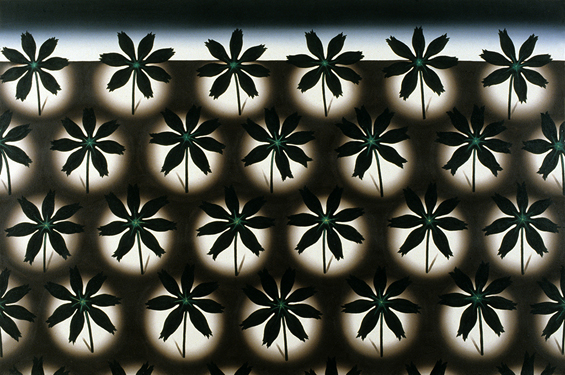 Roger Brown, A Colony of May Apples, 1981, oil on canvas, 48 x 72 inches.
Roger Brown, A Colony of May Apples, 1981, oil on canvas, 48 x 72 inches.
Collections
In preparation for the major project to overhaul our collection catalog database, I queried colleagues in the Historic Artists’ Homes & Studios and At Home in Chicago consortiums and gleaned helpful information about how other sites’ online collection catalogs. James, Nick, and I finally penetrated the mysteries of FilemakerPro, and with inspiration from the Donald Judd Foundation’s databases, we began the process of transforming our primitive system into an astonishing (to us!) system of collection documentation.

We engaged the expertise of Lela Hersh, Museum Fine Art Consulting and faculty in Arts Administration, who advised on the process and gave an introductory lecture to the class. The team created a manual which outlines the process for every step of collection documentation, including photographing in situ and complete object photography, many categories of describing the object physically and in terms of its function(s) and associations, its provenance and “social life,” condition and conservation, and artist/maker information. We created a manual outlining the each step of the process of object documentation. Students selected objects of interest, researched their makers and provenance, documented them thoroughly, and delivered presentations on their findings.
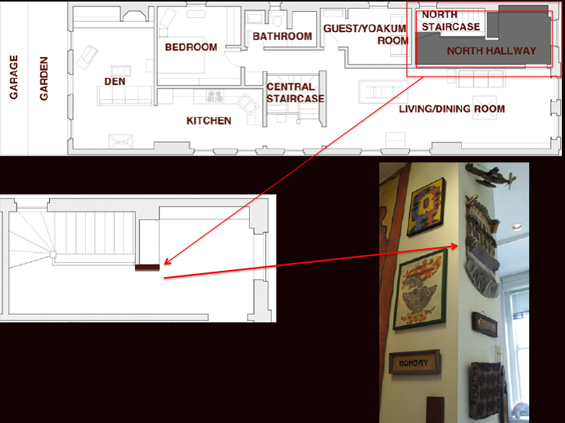
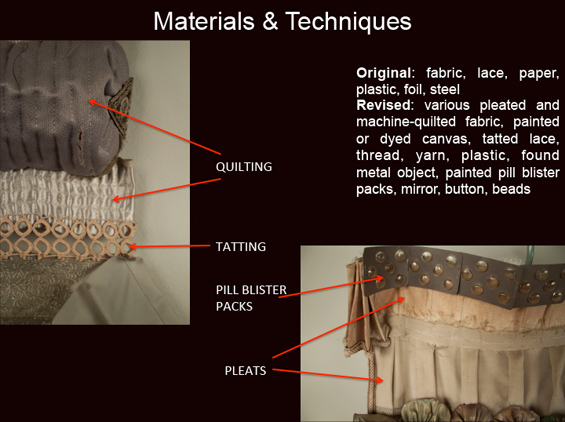 Details from Julie Warchol’s documentation of the Shirl Fedorow work.
Details from Julie Warchol’s documentation of the Shirl Fedorow work.
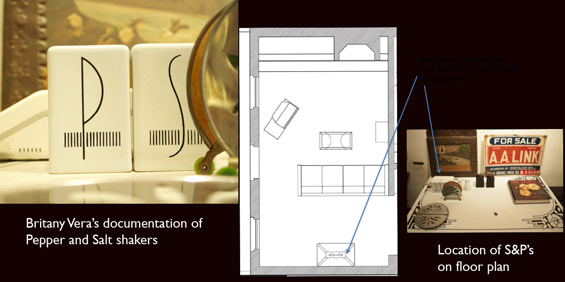
2nd year Historic Preservation grad and architectural drawing wizard Erin Weevers worked at the RBSC (through the Cooperative Education program) this semester. Her job–-which she undertook at record speed and with great accuracy––was to create measured drawings, elevations, and reflected ceiling plans of the second floor, including locating all furniture, so each object can be documented according to its exact location in the collection. Erin’s drawings became a kind of revelatory tool in our project of collection documentation. She went on to make measured drawings of the garden, garage, and first floor. We’ll miss Erin, who’s has a job waiting for her back in Calgary. You can read her blogpost here.


The collection documentation project is now the primary focus of staff and volunteers, well into the future. Peter Rosen, from the International Museum of Surgical Sciences and admittedly “collections obsessed” has signed on to assist.
Roger Brown exhibition in Sydney, Australia
“I look forward to hearing from you regarding an artist I find to be intriguing,
crisp and more eloquent for our own time than many living, working painters.
I am very keen to introduce the work of Roger Brown to Australia
and look forward to further dialogue.”
That email from Evan Hughes, and the ensuing dialogue, became a kind of dream come true, in three exhibitions at the Hughes Gallery, Sydney, in spring 2014.
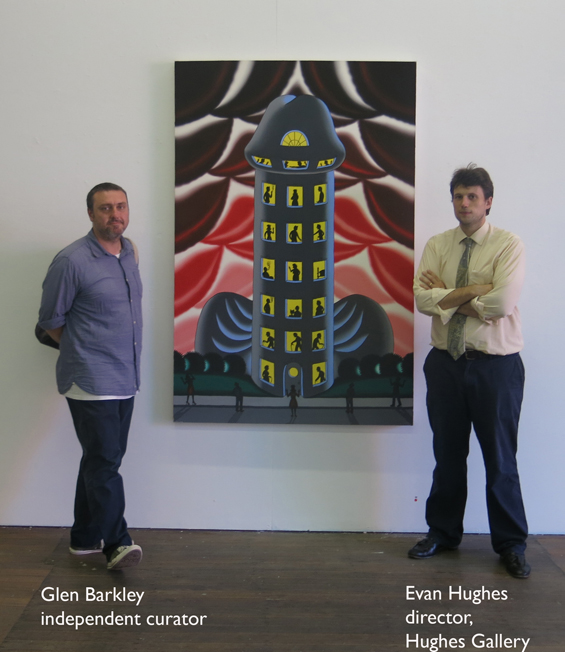
Former director (and current guiding light) Ray Hughes visited Chicago in the late 1970s/early 80s and organized the exhibition Chicago on Paper at his Brisbane Gallery in 1982.
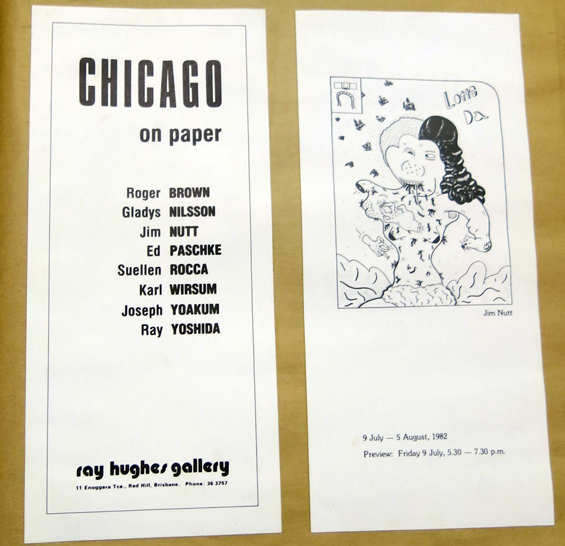
Working with Russell Bowman Art Advisory, the exhibition Roger Brown: His American Icons opened with great fanfare––coinciding with the Biennale of Sydney––on March 21.
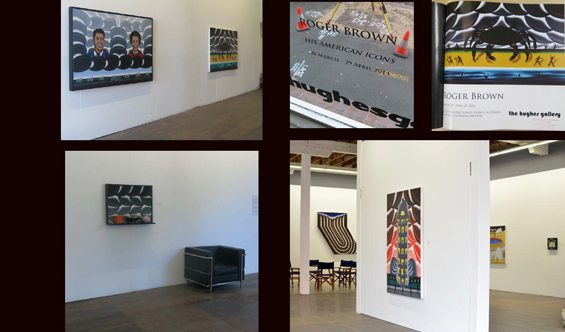
Evan and Ray produced a beautiful catalog and the exhibition received favorable and insightful reviews, and excitement for the work of Roger Brown on the Antipodean shores.
Links to reviews
Tempest in the Windy City
Who are the Chicago Imagists and Why are they in Sydney?
From Sexual Politics to Religion: The Enduring Paintings of Roger Brown
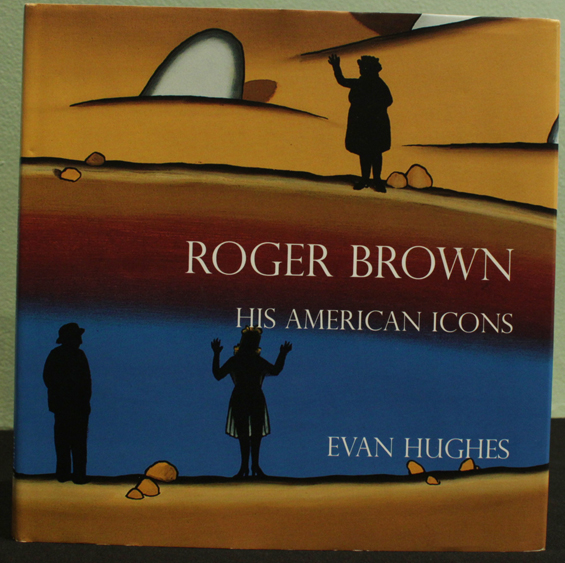
Concurrently on view, the show The Hairy Here (a nod to The Hairy Who), showcased works by Australian artists whose works echo or rhyme with Chicago artists, or in some cases, were influenced by Chicago artists.
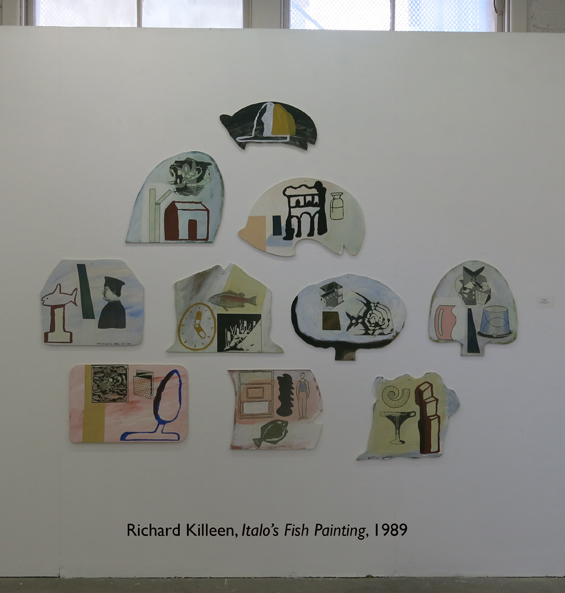
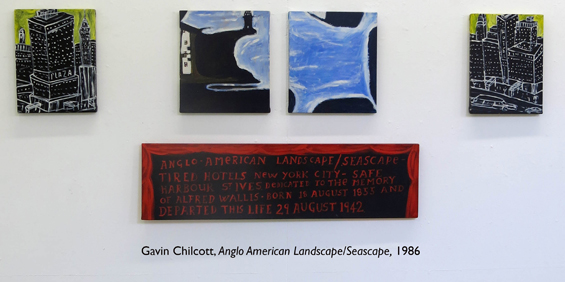

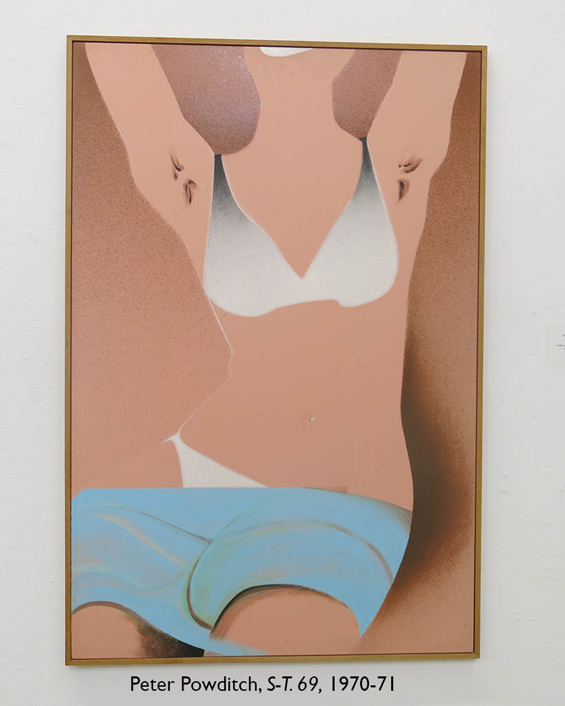
Ray and Evan created an installation in honor of Roger Brown, Collector, with objects gathered from Ray’s incredible home collection. If you were blindfolded (and notwithstanding the long plane ride!), and plunked down in Ray’s rambling, art filled apartment, you might think you were in Chicago, such are the strong shared collecting sensibilities. Following are a few images of the installation, which echoes Roger’s collection, right down to the Wassily chairs.





Following are a few images of Ray Hughes’ home collection:
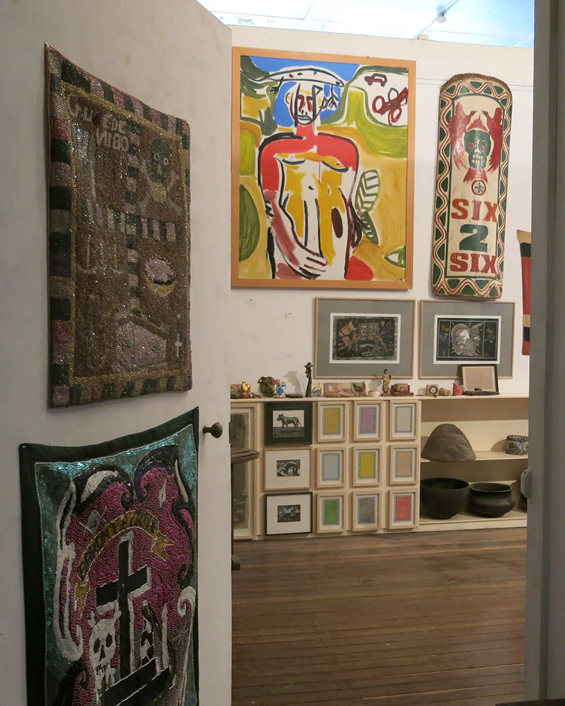
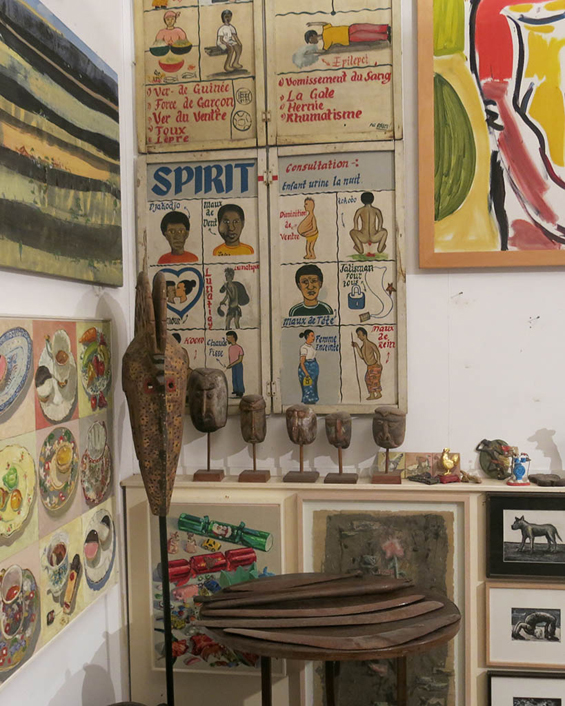
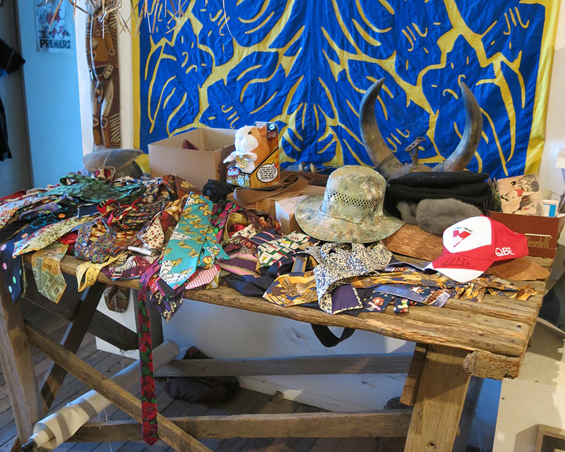
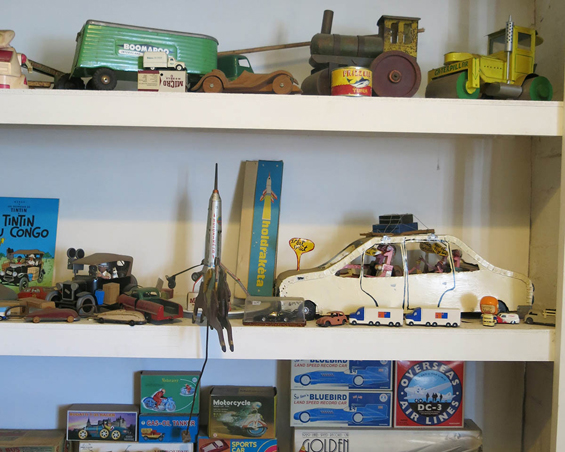
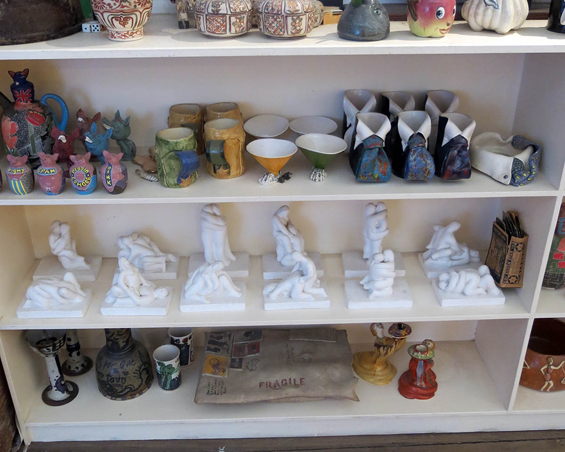
As further evidence of Ray and Evan Hughes’ commitment to Chicago artists, Roger Brown: His American Icons was followed by the current exhibition, Now Chicago! (May 2 – June 10), with works by Isak Applin, Carl Baratta, Gabrielle Garland, Carmen Price, Rebecca Shore, and Geoffrey Todd Smith. A few of the artists traveled to Sydney, to celebrate this exciting exhibition.
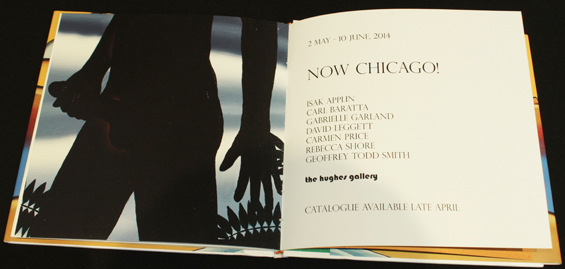
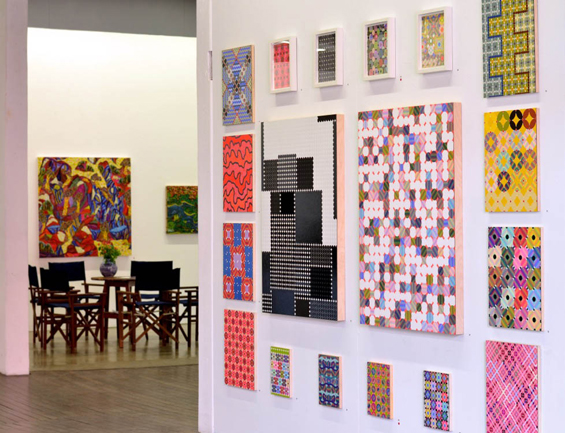

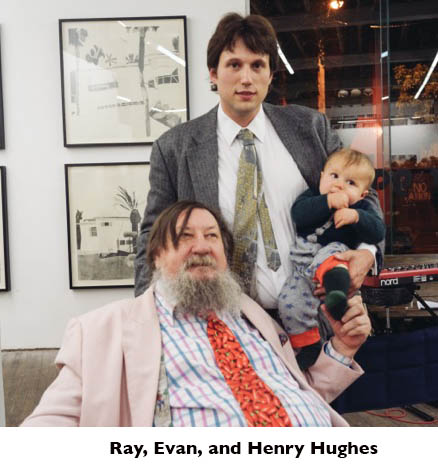
Back to the RBSC.
Spring semester was action packed, with class projects keeping us on our toes.
On the occasion of Amanda Douberly’s Art History course “Modern, Post-Modern, Anti-Modern” I created a 22 minute video exploration of the Roger Brown Study Collection and Roger Brown’s experiences at SAIC interpreted through a Surrealist lens, which you can view here. We couldn’t host all three classes (two w/ 50 students and 1 w/ 100) so we held “Surrealist Saturday at the RBSC” in which students explored the collection in search of Surrealist moments.

A quick overview of staff projects:
James Connolly did extraordinary work on the new FilemakerPro database, worked closely with the Special Collections Practicum class, managed staffing and tours, and many other projects. James taught workshops in Film, Video, New Media, animation and performed in Chicago; he performs in Ohio in June.
Olivia Junell wrote the wikipedia entry for Roger Brown, perhaps the longest entry on an artist.
Gabe Stallings digitally corrected hundreds of images of Roger Brown’s works, creating very high resolution files, which will be used for Artstor, Shared Shelf, and many other purposes.
Erin Weevers created measured drawings of floor plans and elevations of the first floor and second floor, as well as the back porch, stairway, garden, and garage
Annette LePique worked on the master collection database project and other collection organization tasks.
Molly Hewitt and Ariel Fang both began working here in their first semester as freshmen; both are graduating, much to our dismay. They were busy in their final semester and both worked just a few hours/week, doing gallery preparation, cleaning, scanning, and other collection tasks.
FACILITIES
The plan to remove the existing porch and stairs and replace with a code compliant structure is moving forward. Our architect and structural engineer worked with SAIC’s Instructional Resources Facilities Management team on the new design, which will accommodate for the reclining juniper, which we are determined to save. Thanks to Carol Yetken, CYLA, for advise on saving this tree, and for her recommendation that we create a more elegant, Japanese-style support system. Construction is planned for this summer; if protracted, the project will be deferred to summer 2015. The project will require the deinstallation of all objects in the den.


Our spring exhibition, 21st Century Digital Boy, featured works by students in Laura Prieto-Velasco’s fall semester Modeling for Sculpture class, in which students hauled in a very sophisticated 3-d scanner and laptops loaded with modeling software, and explored objects in the collection.


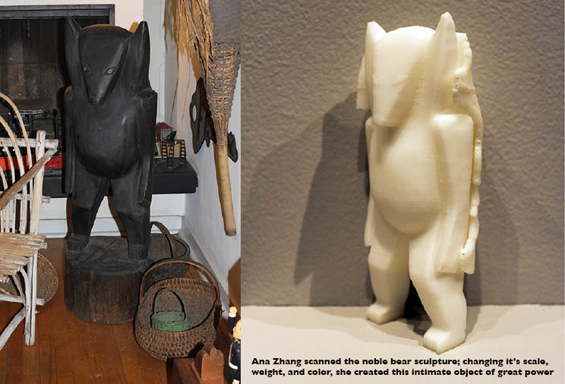
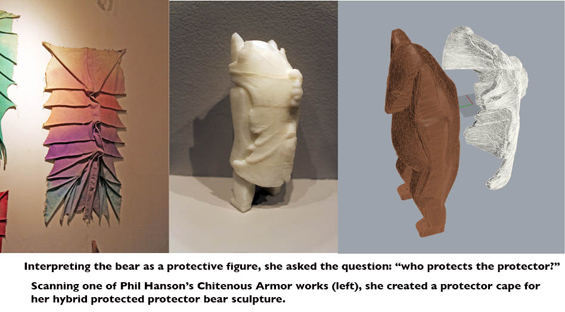

We thank Laura for presenting her students with the RBSC as a source of inspiration, and the artists for their thoughtful responses to objects in the collection. The technology makes many things possible––including predictable 3-d printed objects that don’t necessarily extend or penetrate ideas and meanings contained in the original objects–-so we appreciate the insightful scope of their works.
A Late breaking historical tidbit:
The Lincoln Park Community Research Initiative, though DePaul’s Special Collections and Archives, created an online archive of historic Lincoln Park images, which can be found here. After combing through this waltz down Lincoln Park memory lane, we stumbled upon the ad below, for The Herman Bookbinding Co. (NOT INC.!!!), at 1926. We’re pretty sure his business occupied our building from ~ 1915 to 1917.

We can almost smell the leather bindings and can only imagine what books were bound here, whose hands they were held by, and where they are now. This house full of histories has found its way from a 19th Century tobacco shop to a 21st Century house museum, with a Ford Mustang in the garage and a gift shop in the dishwasher. It’s owned and operated by a prominent art school, and most of the work is done by students. Its purpose is not to lock its history in time but to unlock it, and in the process, to re-write the rules of playing house museum.
-Lisa Stone
Posted in Uncategorized on Monday, April 21st, 2014
The RBSC website is currently being reorganized into a thing of beauty. We retired the old website and we appreciate your patience in the interim.
Please browse through the blog entries to see what we’ve been up to.
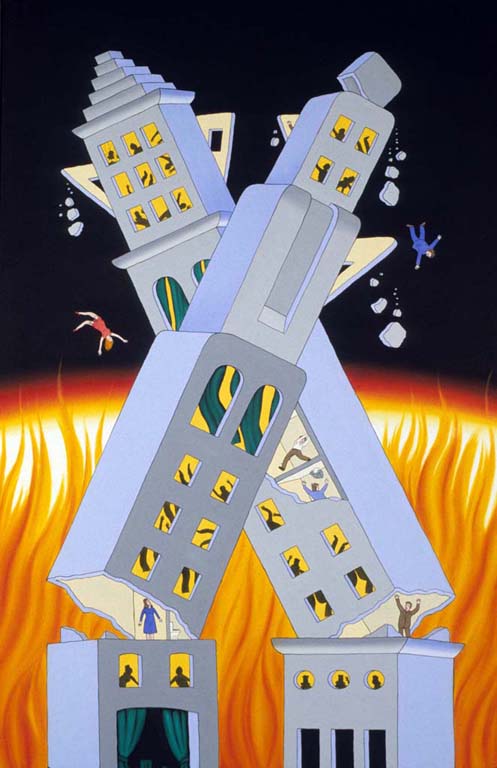
Roger Brown, Ablaze and Ajar, 1972, oil on canvas, 70 5/8 x 46 ¼ inches, collection of the Museum of Contemporary Art, Chicago.
VISIT THE RBSC
As a special collection of SAIC the RBSC hosts classes, projects, and meetings, which can take place mornings, afternoons, and evenings any day of the week. To accommodate academic programming there are no specific days/times that the collection is open to the public. However, we welcome guests from the public and all visits are by appointment. We strive to accommodate all requests; visits are scheduled based on staff availability.
FOR THE SAIC COMMUNITY
The RBSC is open to SAIC faculty, students and staff by appointment. Class visits can include a guided exploration of the collection, a focused exploration of artists, objects, concepts, and histories in it, and/or access to archival materials. There is no fee for SAIC students, faculty, and staff. The SAIC community is invited to bring visiting artists, colleagues, family, and friends to visit the collection; a little advance notice is advised.
Faculty: click here for a link to a calendar that shows days/times when tours are already scheduled.
- Read this calendar in day” mode, not in “week” or “month” mode.
- Class visits are scheduled in three time slots: 9:00 – 12:00, 1:00 – 4:00, and 6:00 – 9:00. If a time slot reads “class tour” or “not available” the entire time slot is booked, even if a class is coming for only part of that time.
- We can’t book more than two time slots in a single day; if two slots are booked, the third reads “Not available.” We are unable to staff 3 classes in a single day.
FOR THE PUBLIC
ARTISTS’ MUSEUM Public Tours: Guided tours include a slide presentation on Roger Brown’s artistic and collecting path and a complete tour of the collection. Tours generally last an hour and a half, and are limited to 15 or fewer guests, $15.00/guest.
SNEAK PEEK TOURS: If you prefer to skip the more formal Artists’ Museum tour, a “sneak peek” visit will guide you through the collection, provide information, and answer questions. All this for $8.00 / guest. A little advance notice is advised, and visits are scheduled based on staff availability.
ARTISTS’ MUSEUM GROUP TOURS:
Tours for museums and other groups: We welcome museum and other professional groups. Tours include a slide presentation on Roger Brown’s artistic and collecting path and a complete tour of the collection. Slide presentations can be tailored to specific subjects or areas of interest by request. Group tours generally take one and a half hours. For groups of more than 15 guests, half of the group will view the slide presentation in the first floor gallery/orientation space, while half the group tours the collection on the second floor, then the groups switch.
There are many restaurants in the area, please feel free to request a list.
- Group tours are limited to 30 or fewer guests.
- The fee is $15.00/guest and can be paid by cash or check on the day of the tour. Apologies, we aren’t equipped to accept credit cards. We’ll be happy to provide you with an invoice in advance and receipt(s) on the day of the trip.
For information or to schedule a visit please email rbsc@saic.edu or call 773.929-2452.
PLEASE NOTE: The Roger Brown Study Collection is densely installed with art and objects. Tours are geared primarily for an audience of teen age and older guests. If you bring young children they must be carefully supervised.
The RBSC is located in a historic 1888 storefront building. The collection is located on the second floor and in two stairways, accessible by stairs only. Our facilities are not presently fully accessible but we are actively working towards removing barriers to accommodate people with disabilities. An in-depth slide presentation with many views of the collection can be shown to anyone unable to reach the second floor. Please let us know if you have special needs in advance of your visit. Our wheelchair ramp is located on the south side of the building. A staff member will open the gate. All visits are scheduled on a first come – first served basis, based on staff availability.
LOCATION / CONTACT INFORMATION
Roger Brown Study Collection
1926 North Halsted St., Chicago, Illinois 60614
voice: 773. 929-2452
fax: 773. 665-4804
rbsc@saic.edu
Directions to the RBSC
The RBSC is located at 1926 North Halsted Street, 1/2 block south of Armitage Avenue on Halsted Street, on the west side of the street.
By public transportation
- CTA Brown Line (Ravenswood El): Exit at Armitage and walk 3 blocks east to Halsted St. Turn right on Halsted and go 1/2 block south to 1926.
- CTA Red Line: Exit at North Avenue, go to Halsted St. (1/4 block east) and walk 2 1/2 blocks north to 1926.
- CTA Bus # 8, Halsted Street Bus, exit at Armitage and walk 1/2 block south to 1926.By car
From I-94, exit at North Avenue, drive east to Halsted Street. Turn left/north on Halsted St. and drive 2.5 blocks to 1926.
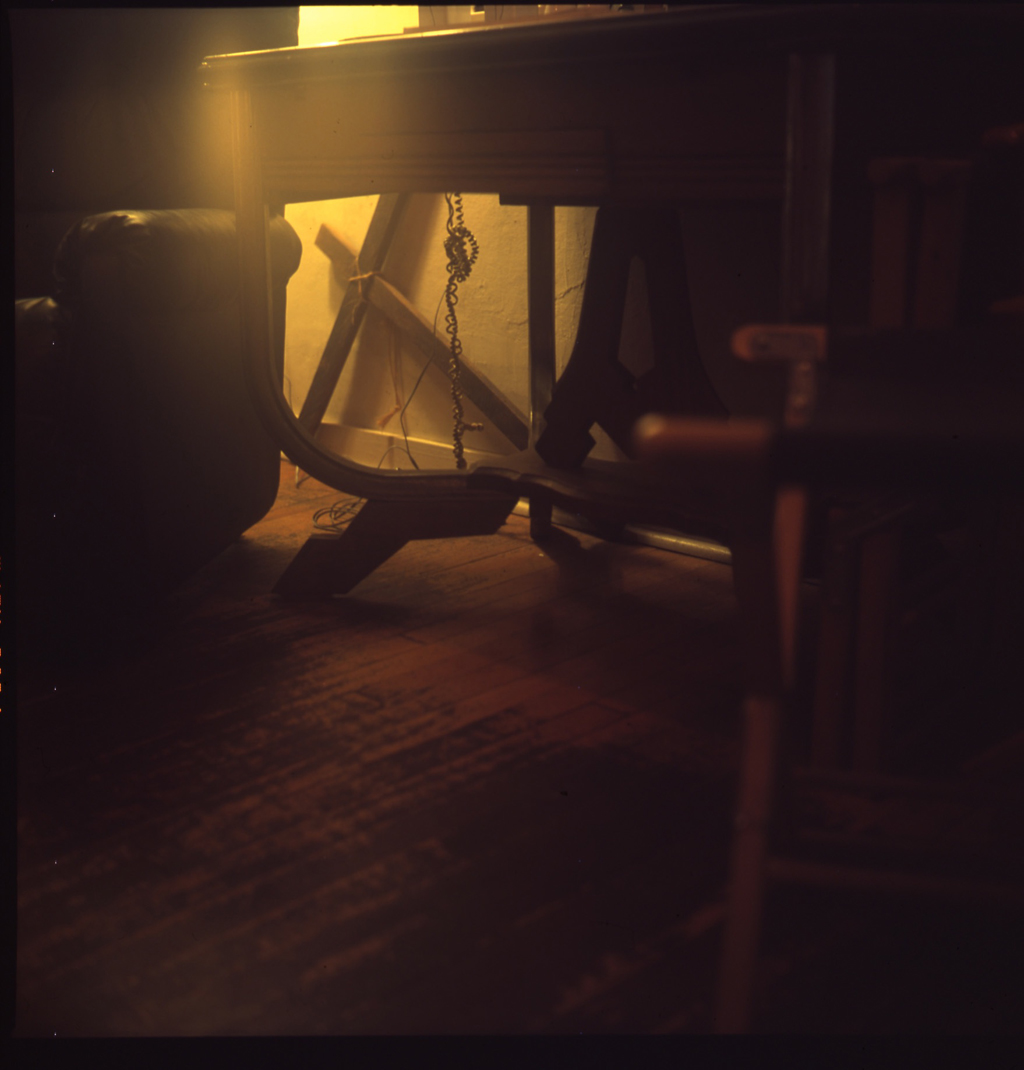
Note from the curator: SAIC Historic Preservation graduate student Erin Weevers has been working at lightning speed, translating the complexity of the building and collections within it into crisp and accurate measured drawings of the elevations, floor, and ceiling plans this semester. She’s made the challenging process look incredibly easy and her drawings have already been invaluable. I invited her to describe the project so far.
Erin Weevers:
In an interesting intersection between my architecturally-dominated experience in the field of historic preservation and the world of Roger Brown, I have found myself working for the Roger Brown Study Collection this semester. Hired as a “design drawing and curatorial assistant,” my task for the semester has been to create interior elevations, plans, and details of the second level of Roger Brown’s Home and Studio.
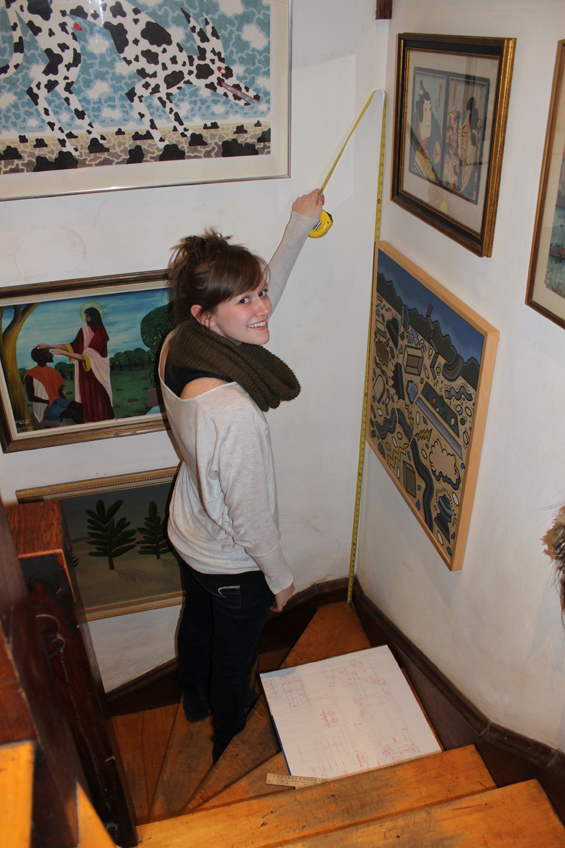
The process of documenting the building has been a fascinating experience. While it feels like I’ve measured every inch of the second story and two stairways, there always seems to be another undiscovered and unmeasured corner of the house – an aspect of the project that reminds me of the collection itself. As I measure the building, I continue to uncover artifacts and objects that I missed at first glance, an easy thing to do with such an extensive collection in place.
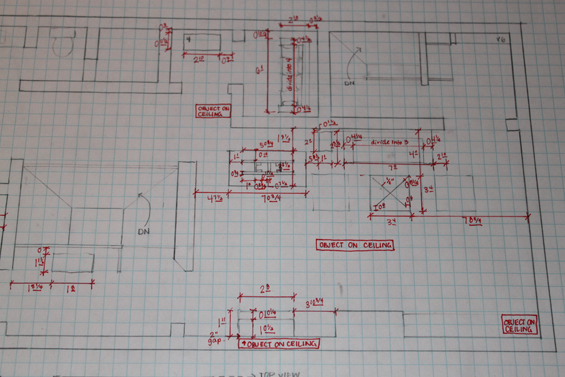
My previous work experience has largely been confined to the field of architectural design firms and, while the softwars used to create the drawings of the Roger Brown Home and Studio are the same, the ways in the finished products are utilized are very different. Rather than completing drawings which conceptually demonstrate how a building is constructed or illustrating how it will be restored, preserved, or otherwise treated, this project documents the house in its current state, serving as a simple, yet identifiably distinct, architectural backdrop for the collection.
The most interesting part of this project, for me, has been understanding how these drawings will contribute to the collection catalogue (a separate endeavor which has instilled a great appreciation for the complex process of sorting and classifying a collection such as this – a distinct entity among museums in and of itself) and attempting to adapt them to suit the demands of the museum.
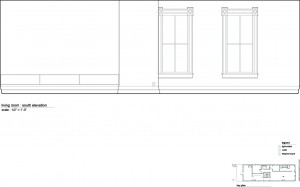
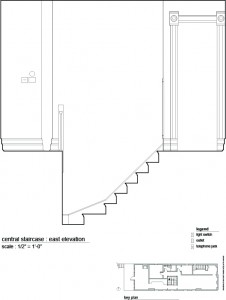
The preservation work I have done has always focused on the building as the primary significant object, and this project has developed into an intriguing combination of illustrating how the building functions within the context of a house museum and also highlighting the important objects contained within it.
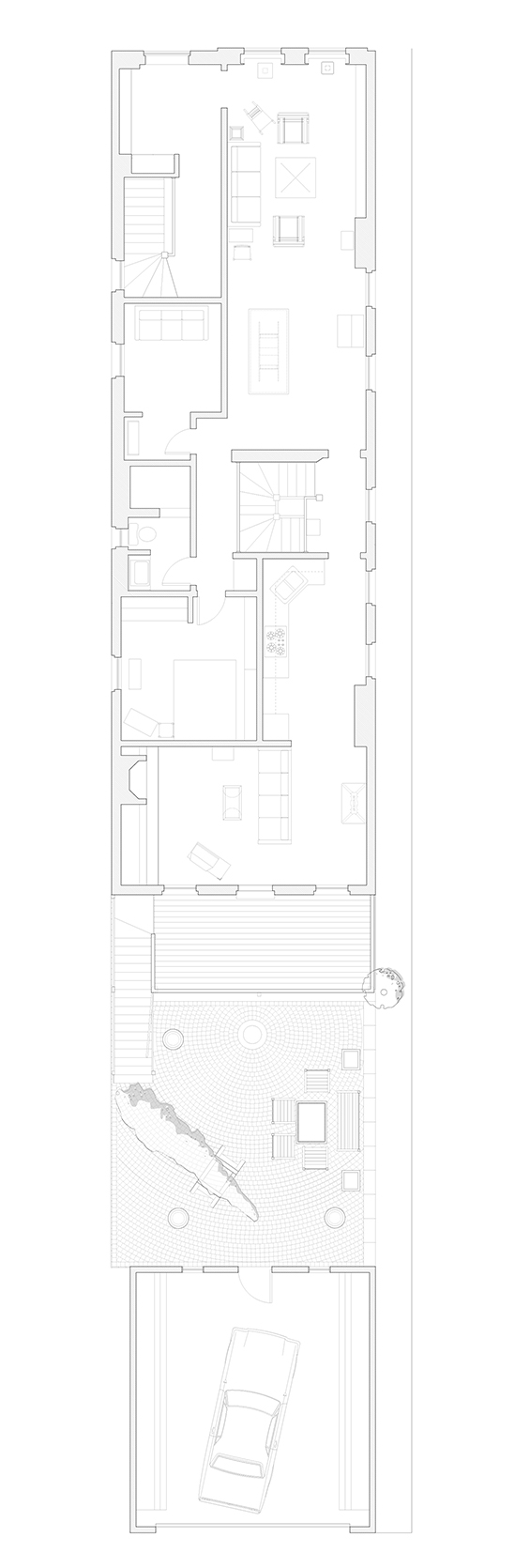
Posted in Staff Projects on Friday, February 7th, 2014
Cracked Ray Tube, an installation by RBSC assistant curator James Connolly, and his collaborator, Kyle Evans, is on view in Discarded: The Afterlife of Everyday Electronics, at The Arcade, Columbia College, 618 S. Michigan Avenue 2nd floor (through March 7). Through hardware hacking the two artists manufacture a synchronized video and audio environment displayed on cathode ray tube (CRT) computer monitors and analogue televisions. This is a treat for those of you who love analog, who miss old TVs and putty colored monitors, who appreciate the finespun, distinctively non-High Def beauty of cathode ray tube generated images, and enjoy an interlude in the dark with all of the above plus low frequency sounds.
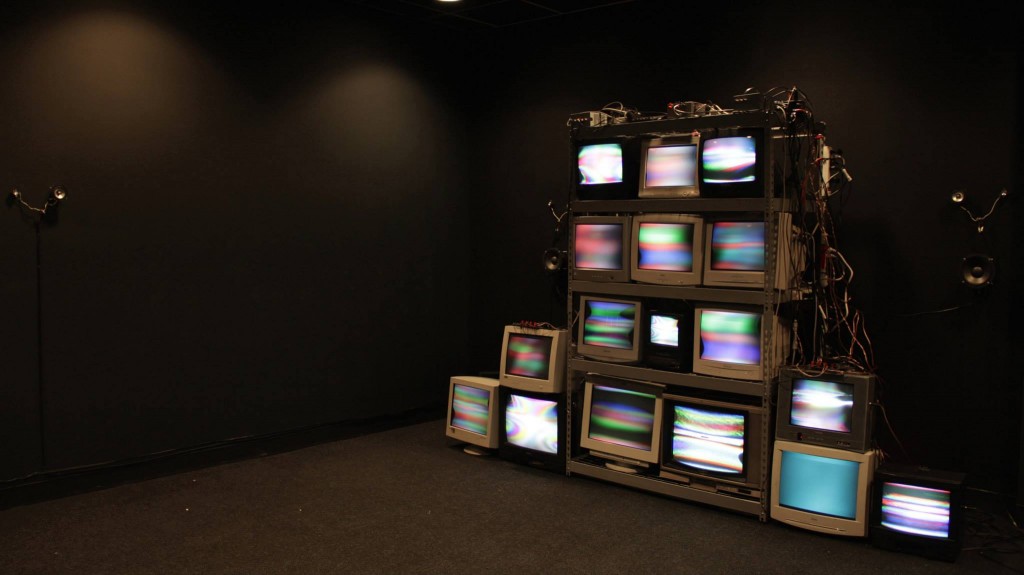
By day James manages all things digital / electronic at the RBSC. His and Kyle’s Cracked Ray Tube work shows a side of James we don’t see at 1926, which should definitely be seen, heard, and felt. Don’t miss this show! There’s a reception and live performance on February 13, from 5:30 – 8:30.
Video and images are below.
http://www.youtube.com/watch?v=oJ0WjXUvVzw
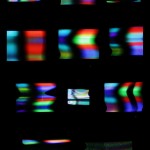
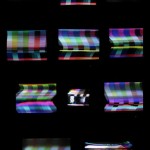
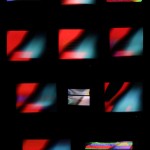
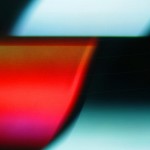
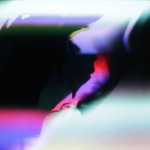
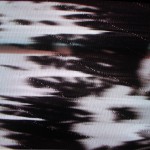
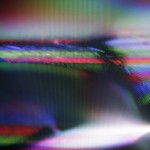
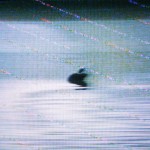

« Older Entries Newer Entries »

























































